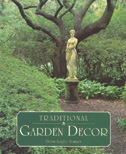Distinctive Touches, Big Impact

I do much of my work in the residential market, and it’s increasingly common for my clients to have relatively small yards for which they want something both unique and special.
In those settings (and in larger ones as well, but often not as critically), I’ve found that it’s the small touches that make the most difference. Frequently, it’s these simple decorative elements that transform designs into unique compositions that reflect clients’ personalities and gives their homes that special feeling.
Yes, you can create terrific swimming pools and other watershapes and include wonderful hardscape or shade structures and landscaping in any project, but especially in compact spaces, the character of those elements may not be fully expressed or realized until you add these finishing touches.
I recently found a wonderful book that shows a broad range of exactly those sorts of decorative elements. Entitled Traditional Garden Decor (Thunder Bay Press, 2001), this 260-page text by Robin Langley Sommer is beautifully illustrated and demonstrates just how exciting some of the simplest things can be no matter the style or the form of the specific decorative touch being applied.
She breaks the treatment of garden decor down into six sections that combine topics in, to be honest, some slightly nonsensical ways. But that flaw aside, Sommer presents one of the most encompassing treatments of the topic I’ve ever seen.
The first section deals with planters and trellises and includes familiar items such as pots and raised planters as well as some unusual ones, such as farm wagons and wheelbarrows. As is the case in all six sections, the styles here range from classic and modern to whimsical, including details drawn from the English and Japanese garden styles.
The next chapter combines a discussion of garden furniture and lighting. With the former, she goes beyond patio and deck furniture to define how benches, chairs and tables can be placed strategically throughout a garden to create destinations. With the latter, the coverage is fairly thin and refers mainly to showier fixtures such as bollards and lanterns.
The third section is about pathways and borders. Here, she explores some interesting path treatments that go well beyond stone and concrete to include gravel, decomposed granite and even grassy pathways. (Personally, I’ve always liked using grass as an interesting twist on conventional pathway materials.)
Now you can purchase the title reviewed here — and other books reviewed by Mike Farley — through our online WaterShapes Store! Click here.
She follows this with a treatment of sculpture and waterfeatures. This might seem a shopworn pairing, but she spices things up with some interesting uses of bronze and stone sculpture as well as birdbaths and Japanese-style waterfeatures. Then she moves on to shelters and sanctuaries, a category in which she includes several familiar structures such as gazebos and pavilions along with some surprises, including bird sanctuaries.
Finally, she delves into folk art and found objects, which folds things back around to the unusual uses of farm implements in the first section and adds in appealing applications of discarded irrigation materials. All in all, she makes a persuasive case for seeing these items as potential sculptural elements.
With its broad coverage and odd range of styles and objects, Sommer provides us with a terrific idea book for which I’ll find many uses as my clients and I discuss ways of decorating spaces from small to grand and try to define key finishing touches that will give these projects personalities all their own.
Mike Farley is a landscape designer with more than 20 years of experience and is currently a designer/project manager for Claffey Pools in Southlake, Texas. A graduate of Genesis 3’s Level I Design School, he holds a degree in landscape architecture from Texas Tech University and has worked as a watershaper in both California and Texas.









